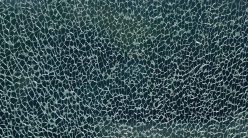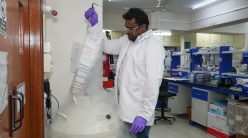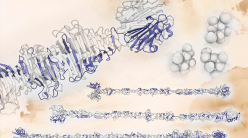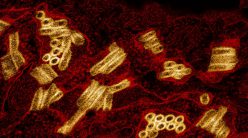Researchers are using science to improve our coffee
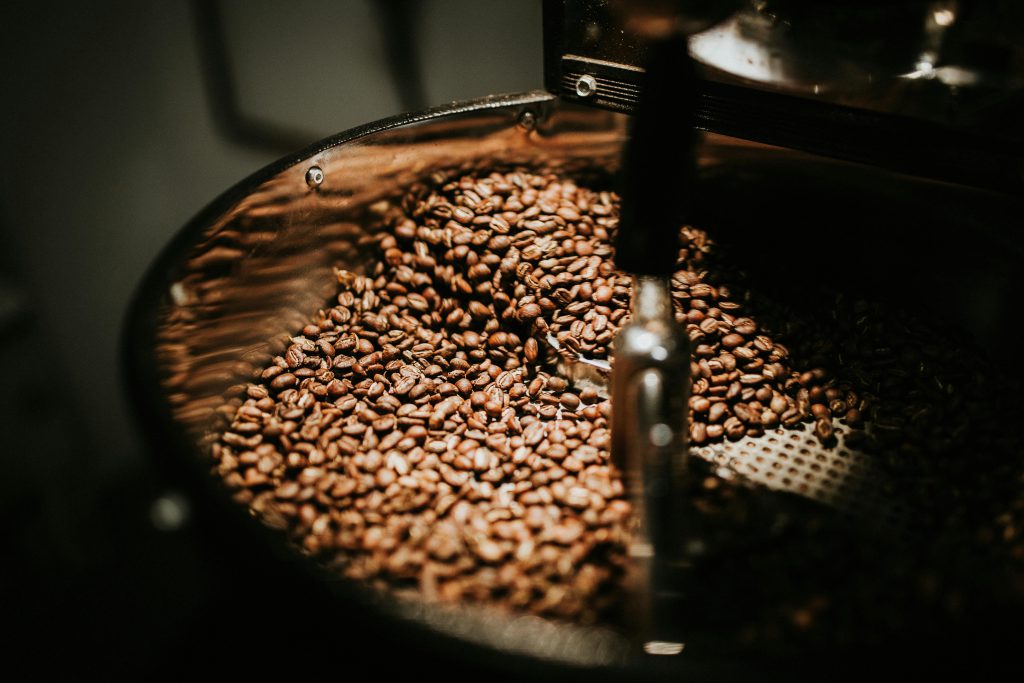
It’s a crisp, windy morning in Bengaluru. I open my jar of fresh coffee powder and pack some tightly into my coffee filter. I then gently pour some boiling water over the bed of coffee grounds, filling it to the brim. Watching the water burble over the dark brown powder, I take in the rich aroma of the myriad little molecules released by the grounds. I cover it with the lid and wait.
The water starts seeping through the coffee bed – gravity helping it weave its way around each granule, adopting the flavour as it makes its way to the bottom. The water – rather the decoction at this point – softly drips into the bottom container.
For people who make filter coffee at home, there’s nothing particularly intriguing about this process; it is, at best, a comforting ritual. However, as it is for most things in the kitchen, there is precise science behind every seemingly mundane step in preparing coffee.
From growing coffee beans to roasting, grinding, and brewing, it is as much a scientific journey as it is a gustatory one
Take, for example, the water seeping through coffee grounds. Scientists have looked at how exactly the size of these grounds influences the strength of the coffee (pro tip: don’t grind too fine or too coarse). From growing coffee beans to roasting, grinding, and brewing, it is as much a scientific journey as it is a gustatory one. Researchers around the world are trying to further understand coffee, not just to brew a better cup but to make the ritual of coffee drinking more sustainable.
Coffee and conservation
Arshiya Bose, a scientist-turned-entrepreneur based in Bengaluru, was doing her PhD at the University of Cambridge in 2014. Researching the ecological and social outcomes of sustainability certifications for coffee, she learnt that these processes don’t really help ecosystems and farmers’ lives. She started Black Baza Coffee, a for-profit company, to work with farmers and ensure that their coffee plantations do not affect the local ecosystems.
Globally, companies have been shifting towards growing coffee under the sun for higher yields in the short term, leading to deforestation. “In the Western Ghats, particularly in some of the largest coffee-growing districts, there’s been quite a lot of removal of forest cover,” admits Arshiya.
To combat this, she and her team are supporting small-scale farmers who grow coffee under native tree cover and use sustainable methods, like avoiding chemical fertilisers and pesticides. They also observe large wildlife movement around the farms through camera trapping, conduct surveys of insects and birds, and keep an eye on soil biodiversity. “We monitor certain indicator species, like bees, beetles, or earthworms, that tell us this kind of farming practice is having a positive impact,” says Arshiya.
The Black Baza team is also exploring how the post-harvest process influences coffee flavour. After pulping the coffee fruit (removing the fleshy part), a sticky, sugary layer called the mucilage remains on the coffee bean. As the bean is dried under the sun, this mucilage gets fermented naturally, leading to unique flavours.
“You can wash the bean, [removing] the mucilage, so essentially reducing the amount of fermentation; that produces a cleaner flavour,” Arshiya explains. “Or you can carry out a controlled fermentation, which allows certain bacteria to do really well.” Lactobacillus is one example of bacteria that work on freshly pulped coffee fruits, producing various metabolites and acids that impart novel flavours. Arshiya and her team have co-fermented freshly pulped coffee fruits with sugarcane juice, ginger or kombucha.
They are also working with the farmers to monitor how factors like the pH or temperature of the fermentation change with time. The pH, for example, always goes from alkaline to acidic as the bacteria start metabolising; once it hits an optimum level, the farmers stop the fermentation to prevent the coffee from becoming too sour.
“It’s so much fun; it’s like being in a chem lab,” Arshiya says, with a laugh.

Roasting with rigour
After pulping the fruit and drying the coffee bean, the next step is to roast it. “The coffee bean has a lot of moisture and a bunch of sugars in it. The first part of the roasting process is pushing the moisture out,” says Arshiya.
Roasting coffee is almost like making popcorn. As you start applying heat, the beans expand, building up pressure and volatile gases like carbon dioxide. As the temperature rises, the pressure reaches a tipping point, popping the beans open and letting out the moisture and gases with a sharp “crack”, called the first crack. Once the bean has dried out, it starts changing colour with more heat. The beans get browner as the Maillard reaction – a chemical reaction between amino acids and sugars that leads to the formation of melanoidins – swings into motion. Melanoidins give browned food its distinctive flavour.
If the roasting process is stopped soon after the first crack, the result is a light roast with fruity coffee beans. However, with continued browning, a second, softer crack signals the release of more pressure and gases from the beans and oils start to come up. By now, the beans are almost black with more caramelised flavours, known as a dark roast. The medium roast falls between two cracks and has a smooth, sweet taste, less fruity than a light roast and not as rich as a dark roast.
Roasters can vary how fast they change the temperature with time – which is the rate of roasting or the roast profile. Laudia Anokye-Bempah, a graduate student at the University of California Davis Coffee Center, USA, works on the kinetics of coffee roasting and is particularly interested in how changing the roast profile affects coffee beans.
‘Many people have no idea that so much goes into making a cup of coffee’
In a 2024 Scientific Reports paper, Laudia and her co-authors looked at how titratable acidity (TA) in the beans – a measure of the total amount of acids – changes with the roast profile. They chose to measure TA because it correlates with the sourness of the coffee. She found that regardless of the bean or roast profile, the TA is highest at first crack. By the time of the second crack, the TA nearly drops to the levels at the start of the roast. “When people buy a light roast, [they are] getting coffee with maximum acidity. So, your coffee will be bright and sour,” Laudia explains. “When people buy dark roast, they are buying coffee with minimum TA, [which may taste] dull and not as fresh or sour. ”
In another recent Scientific Reports study, Laudia and her teammates showed that the colour of coffee beans changes similarly during roasting, irrespective of the bean or roast profile. However, how fast the bean colour and acidity change still depend on how you roast the beans. Which means, even if acidity peaks at first crack and decreases by the second, how quickly it changes between the two points can vary. Depending on when one decides to end the roast, these variations could affect the taste and appearance of the coffee.
“Coffee making is complicated,” Laudia says in a UC Davis news article about her work. “Many people have no idea that so much goes into making a cup of coffee.”
When size matters
After roasting, the coffee beans have to be ground. How finely or coarsely one should grind the beans depends on the desired filter or brewing method.
For example, for an espresso – where hot water is forced through a bed of packed coffee at high pressure – the finer the grounds, the larger the quantity which can be packed into a smaller volume. The increased surface area to volume ratio allows for more extraction of flavour. However, a few years ago, Christopher Hendon, Associate Professor of Chemistry and Biochemistry at the University of Oregon, USA, discovered that if the grind is too fine, then the coffee extraction yield goes down.
Christopher – a materials chemist who also runs a coffee lab – wanted to understand why espresso shots have variable tastes. Using mathematical modelling and experiments, he looked at what set of conditions gives maximum extraction yield (EY) – the ratio of the mass of extracted liquid coffee to the mass of dry coffee used.
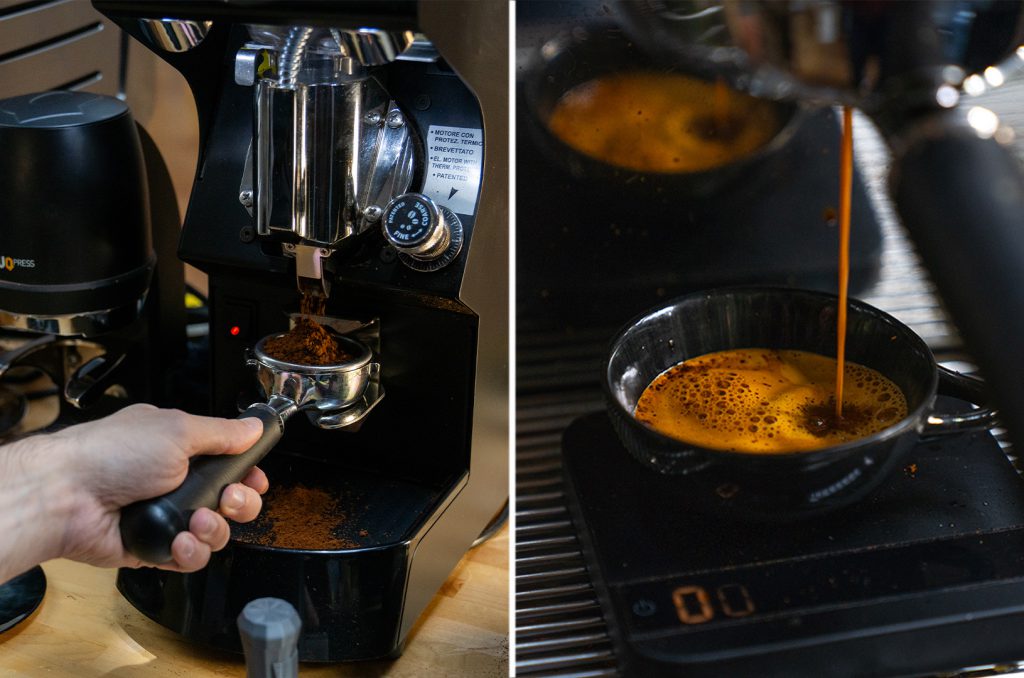
In a 2020 Matter paper, he and his team described that there is a critical grind size at which EY is maximum; any finer and the espresso shots become less concentrated and more variable. “At some point, [if] you grind fine enough, the particles seem to clump together and give rise to inhomogeneous flow,” he explains.
They found that even if you use less dry coffee mass but grind a bit coarser, water flows homogeneously through the bed, giving more concentrated coffee. When they implemented this technique in a small specialty coffee shop in Oregon, it both reduced the amount of coffee used and the time taken for making the shots.
Diving deeper into why grinding finer leads to poorer extraction, Christopher and his team found that grinding really fine forms static, which causes the clumping. “You think you have a high surface area. But effectively, you’ve got relatively low surface area,” he explains.
They also found a quick hack to turn off this static buildup: simply squirting water on coffee before grinding it. But the role of water remains a mystery. One possibility is that being a good dielectric medium, water can store charge and reduce electrostatic forces. But Hendon is more excited about the bigger picture, that water seems to work so well at all.
“It can allow you to access more grind settings for espresso, and so you can start to push up the extraction yield,” he says. “I could then do espresso experiments and show that there’s actually a meaningful difference in the espresso you prepare.”

Perfect pour-overs
The pour-over is another method to brew coffee. The trick is to pour hot water over the coffee grounds inside a conical coffee filter and collect the filtrate below. How you pour influences the taste.
Arnold Mathijssen, Assistant Professor at the Department of Physics and Astronomy, University of Pennsylvania, and his lab were curious if physics can help with the perfect pour-over.
“We have a lab notebook on our coffee table, we write down our experiences every day, and then at some point you start finding patterns,” Arnold says. “There is quite a lot of research in the physics of avalanches and also in the physics of liquid jets. However, the two combined have not been studied as much, and that is exactly what a pour-over coffee is.”
Detailing their findings in a recent Physics of Fluids paper, the researchers simulated a pour-over coffee set-up using transparent glass beads inside a conical filter. While pouring water into the bed of beads, they imaged the set-up using a laser sheet and a high-speed camera to track the movements inside the cone.
They used a gooseneck kettle, through which water falls like a gentle jet, and poured from different heights.
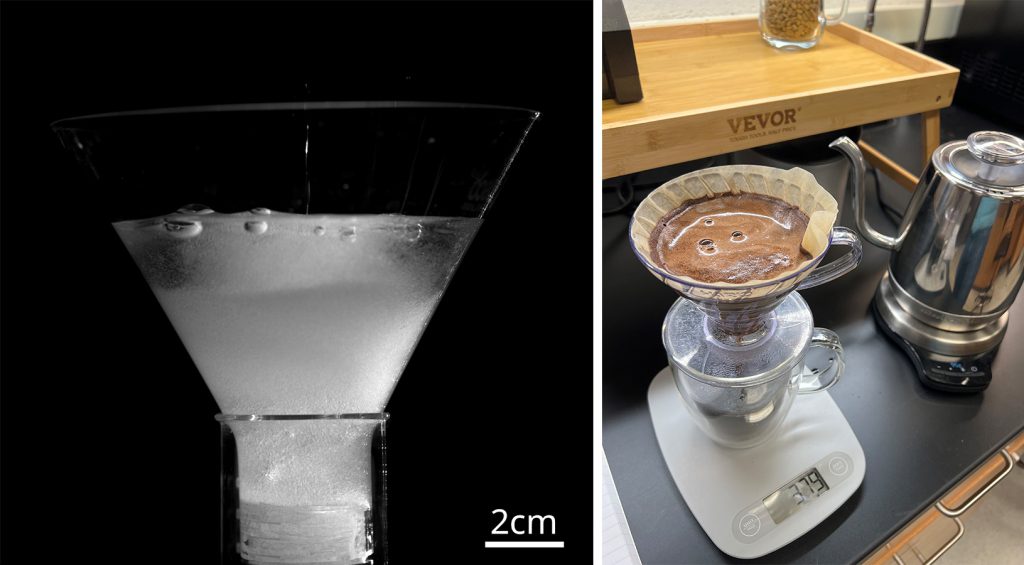
When the kettle was 10-30 cm above the cone, the beads seemed to mix better with the water. They found similar results when repeating the experiments with coffee grounds; pouring steadily from this height increased the mixing of the coffee grounds with the water, thus improving extraction by a few percent.
This is a result of the “avalanche” effect, created by the falling water eroding into the centre of the coffee granule bed. “A very slender stream of water can still dig down quite deep, as long as it has enough momentum,” Arnold explains. “If you dig all the way down the centre of the cone to the bottom, the coffee grounds on the side start sliding down the cone walls, like an avalanche. They mix with the water, get resuspended, move upwards, and aggregate again at the top of the cone, on the sides. And then the whole thing starts over again.”
Pouring slowly also helps – water gets more time in contact with the coffee grounds. However, a slow stream cannot create a dramatic avalanche effect, thus lifting the kettle a bit higher increases the momentum of the liquid jet. “But don’t go too high, or too slow, because then the jet will break up into small droplets, and then the avalanche effect disappears,” Arnold adds. “Go slowly but steadily.”
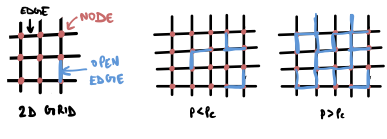
The math of percolation
In the South Indian filter coffee or the Kyoto-style cold brew process, water meanders through a porous bed of coffee grounds and slowly drips down to form the decoction or the brew. This is loosely analogous to what happens in the mathematical theory of percolation.
Imagine an infinitely large 2D grid, with nodes connected by edges. Sometimes, the edges may be open, with some probability p. When open, water can pass through, or else the water is trapped. In the context of coffee grounds, the nodes represent the packed coffee particles, and the edges are the spaces between them. When the coffee grounds are too fine and are tightly packed, the space between them (edges) will be closed, and the probability of opening edges (p) is small. This will prevent water from passing through the grounds properly, thereby leading to very little decoction. Conversely, if the grounds are very coarse and loosely packed, there will be lots of open spaces as p will be high – water will flow through fast and end up in a dilute decoction.
There is one particular value of p, called the percolation threshold pc, such that if p is smaller than pc , then there are no infinite open paths. But if p is greater than this threshold, then there exists a unique infinite connected component consisting only of open edges. “If p is large enough, the water will find a path to infinity,” says Arvind Ayyer, Professor in the Department of Mathematics, IISc.
For a 2D grid, mathematicians have proved that pc equals 1/2, and that there are no infinite open paths at this critical threshold. That is, there is a continuous phase transition – from being trapped to passing through.
One can imagine that above this critical point, the water – instead of being trapped in the bed of coffee grounds – can just pass through, thus finding this threshold might lead to the perfect decoction. But in 3D, what happens at pc is still unknown. “Proving that the phase transition is continuous in 3D is a very big open problem,” says Sanchayan Sen, Associate Professor in the Department of Mathematics, IISc.
While Arnold’s work may have focused on pour-over coffee as a physics phenomenon, he, like others, was motivated by the recent rise of coffee prices in the US. Rising temperatures have made it harder to grow the Arabica coffee plant, which prefers a slightly cool climate. Unpredictable weather patterns have also led to prolonged heavy rains and increased periods of drought, which affect the plant’s productivity. Places that grow coffee – like South and Central America, Indonesia, and India – are all grappling with climate change, making it one of the most urgent issues facing the coffee industry. Both coffee-suitable land and worldwide yield are expected to decrease by 2050.
Coffee is one of the most consumed beverages in the world, so it is no wonder that researchers are focused on cracking the science behind it. But, as Christopher points out, the goal is not just to brew the best cup but also to be more conservative with the coffee we consume. “How do I get more high-quality flavours and use less coffee so that we have a more sustainable future?” he asks.
“If we can reduce the amount of coffee needed by just a few percent, we could alleviate the demand on coffee beans,” Arnold says. “If everybody would do this every day, it could make quite a big difference.”
(Edited by Sandeep Menon, Abinaya Kalyanasundaram)
